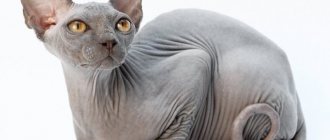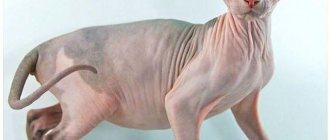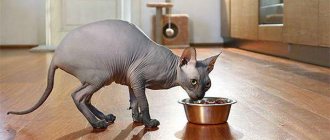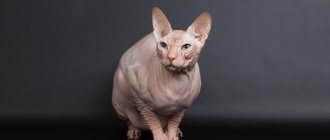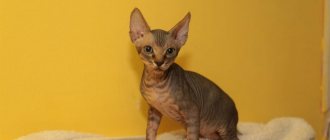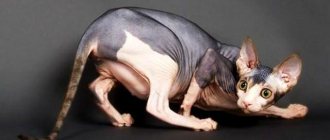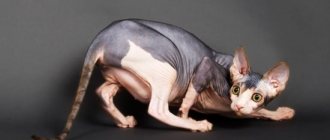What will you learn from the article?
- The history of hairless cat breeds
- Hairless cat breeds Don Sphynx
- Canadian Sphynx
- Petersburg Sphynx or Peterbald
- Ukrainian Levkoy
- Bambino
- Elf
- Dwelf
Hairless cats are not a product of artificial origin, they are not the result of a laboratory experiment, but a breed that was born naturally. More precisely, not one breed, but several, but more on that below.
How the Sphynx breed was developed
Hairless Sphynx cats got their name from the famous mythical guardian of the pyramids because of their appearance. Attracting a whole range of eyes, they have gained incredible popularity among feline fans. But few people know that the breed was first mentioned many years ago in ancient papers. These exotic creatures were sacred.
Today, there are several breeds of Sphynx cats, which create one type of hairless cat. The breed of Canadian cats without fur appeared at the moment when an inconspicuous cat gave birth to a hairless kitten. After numerous studies, it was discovered that a special gene was inherited, which in turn is responsible for the lack of hair.
The Don breed of hairless cats was also discovered by chance. They tried to cure the cat, which was found on the street, for a long time, but it turned out that the pet was completely healthy. Her offspring were also distinguished by their lack of hair from other cats.
After some time, as a result of crossing the Don breed and a shorthair cat, a new line of the genus of all St. Petersburg hairless cats arose.
The history of hairless cat breeds
1830
Naturalist Johan Rudolf Rengger described South American cats without hair.
1903
A pair of hairless cats (Nelly and Dick) was bought from the Indians of Mexico. The leader of an Indian tribe claimed that bald cats were a special Aztec breed. There were no offspring from Nellie and Dick. 1975
A classic cat gives birth to a non-standard hairless kitten, which its humorist owners dubbed Epidermis.
1987
Rostov-on-Don. Elena Kovaleva finds an almost hairless cat on the street, later named Varvara. From mating with the shaggy cat Vasily, Varvara consistently produced regular and hairless kittens in her litter.
Description and general breed standard
The Sphynx cat is naturally endowed with a slender and, not surprisingly, strong and muscular body. The main difference is, of course, the skin, which has no hair or barely noticeable cover.
It is a mistake to assume that all representatives of this breed are bald - the Sphynx with hair is not new for a long time.
What also makes the Sphynx stand out is its large, slightly pointed, erect ears and almond-shaped eyes. The head is diamond-shaped. The nose is straight and flat. In general, such an elegant muzzle is a bit reminiscent of unearthly creatures. The slender, flexible body flows smoothly into long limbs and a straight, thin tail.
The color of the sphinx can be completely different: plain, spotted, two-color, bicolor (when in addition to one main shade there is another color). Also, a cat can simply tan, thereby changing color.
As for the pregnancy of Sphynx cats, it proceeds quite favorably and calmly. During this period, you should not introduce the expectant mother to new foods, but you need to feed her more often. Despite the uniqueness of the breed, a pregnant Sphynx cat needs the same care as all felines during this period. Between two and five kittens are born in a litter.
Prices for kittens
If just a few years ago hairless cats were very rare and breeders set exorbitant prices for kittens, today bald cats are quite common and prices have fallen. So how much does a hairless cat of different genetics cost?
A kitten of the Don Sphynx breed can be bought in Ukraine for 2,000 hryvnia, and in Russia – 4,500 rubles.
The Canadian Sphynx costs more - 7,000 hryvnia and, accordingly, 15,000 rubles.
Peterbald in Kyiv is sold for 3,500 hryvnia, and in Moscow for 8,000 rubles.
It is almost impossible to buy a bambino, an elf and a dwelf in our open spaces.
Features of the Sphynx breed (comparative table of species)
| View | Canadian | Donskoy | Petersburg |
| Head | Slightly long head. Straight and flat nose. There is a depression between the nose and forehead. Pronounced cheekbones. The neck is not too long and muscular. | Pronounced brow ridges. There are vertical folds on the flat forehead. There are also folds on the head and neck. The nose is straight and flat. | Diamond shaped head. The forehead is flat. The profile is slightly convex. The neck is thin and long. The cheekbones are flat, not sharply expressed. |
| Ears | Erect and wide. | Slightly tilted forward. Wide, with rounded ends. | Slightly pointed tips. The wide ears are set far apart. |
| Eyes | Wide, almond-shaped, slightly slanting. Color may vary. | Almond-shaped, there is an inversion of the eyelids. The color can be any. | Small, almond-shaped. The color is often bright green or blue, but blue is also possible. |
| Body | Flexible, muscular body of medium size, soft and very warm. The tail is long and straight. | ||
| Weight | 3-5 kg | ||
| Cover | Elastic and thick. To the touch it resembles suede, the length is no more than 2 mm. | Elastic and soft, hot to the touch, folds present. In cold weather, it may become covered with fluff in some areas. | Elastic, has a large number of folds, especially on the head. Hot to the touch. |
| Color | Can be varied. There are both single-color and two-color spotted sphinxes. | ||
Ukrainian Levkoy
This breed was developed in Ukraine. The breeder wanted to breed a cat that would have no hair and would have fold ears. And in 2004, this breed was officially registered. They have not yet become widespread, but their number is increasing.
Interestingly, their name comes from their country of origin and the gillyflower flower, whose petals their hanging ears resemble.
The cat has a rather long body. It is strong and muscular. The head is wedge-shaped, there are wrinkles on the forehead, and the cheekbones are very prominent. The animal's ears are folded in half. Behind them are several folds. The eyes are oval-shaped, slightly slanted. They can be of different colors, but usually it is blue. The skin of the levkoy is soft, there are folds on it. There is also another type of left-handed dog, in which the ears stand upright.
By nature, these cats are very kind. They are loyal to their owner and also not at all aggressive. They love when they get a lot of attention. Cats have a hard time being alone. They always need company. They get along well with small children and will participate in their noisy games.
Cats are highly trainable, they are smart and have high intelligence. Sometimes they can be very intrusive.
Levkoys are good with other pets. They do not have hunting instincts, so even pets such as rodents or birds will still be safe.
Caring for lefties mainly involves cleaning their skin from sweat and dirt. It is also necessary to protect these hairless pets from hypothermia. In the room where they are kept, the temperature should not be lower than 25 °.
They should be bathed weekly using baby shampoo. After water procedures, they must be carefully dried with a soft towel so that they do not catch a cold.
When the claws grow, they need to be trimmed with a nail clipper. You should keep your ears and eyes clean and clean them, if necessary, with a damp sponge.
Several times a month, Levkoys can be taken for a walk. Just avoid direct sunlight, and in cool weather, they need to wear clothes.
Sphynx cat character
At first glance, if you look at a photo of a Sphynx cat, it may seem that the pet is very unfriendly and rude. In fact, Sphynx cats have a character characterized by unimaginable warmth and love for their owner; they are very bored in his absence.
Cats quickly get along with other pets, if any, and show care and friendliness, not even allowing the thought of causing harm. They get along well with children, because they love to be the center of attention. Pets are amenable to swaddling in children's games and will not be angry if a child decides to decorate a cat's body with a design.
Sphynx cats are one of the most peaceful, unforgiving and altruistic breeds. Despite all the significant advantages, if you don’t give your kitten enough attention and affection, the animal can become embittered and aggressive.
Knitting features
Before breeding Sphynxes, it is necessary to take into account that completely hairless cats cannot be mated with the same cats. As a result of such a union, offspring with various pathologies may appear. Ideally, one of the parents will be bald, and the other will have brush or velor.
The cat should go on a “date”. Ideal for mating are individuals who have already gone through two heats - this is approximately one and a half years old. A sign for a cat to visit is the animal's excessive affection - the cat rubs against everything, and when you stroke its back, it purrs, arches and trembles. A cat will help you figure out exactly whether he is ready for mating - if the kitty arrived on time, he will immediately show his readiness for affection, filling the room with a loud cry. If the time has not yet come, the cat may leave altogether. A guaranteed result can be achieved only after several matings.
Care and maintenance of sphinxes
Since the Sphynx kitten is naturally hairless, you must remember and follow the rules for caring for your pet. The Sphynx's skin secretes a certain lubricant, in other words, sweat, in order to maintain its elasticity. The owner needs to remove excess moisture from the skin every day and bathe his pet frequently. Otherwise, the cat will begin to leave brown spots with a very unpleasant odor wherever he decides to lie down, that is, everywhere.
Ears need to be washed regularly. The skin in these areas is quite thin; it should be treated delicately with a special lotion. Since the eyes are not endowed with eyelashes, they must be wiped daily.
The average body temperature of a Sphynx cat is 38-39 degrees. However, owners should not forget that their pet is deprived of fur and during the cold period it is necessary to stock up on warm clothes. Otherwise, your pet may catch a cold. Also, your pet may get burned if it stays near the battery for a long time.
Kittens' teeth and claws should be cleaned with gauze soaked in herbal infusion. For adult cats, it wouldn’t hurt to buy a special brush and suitable toothpaste. For claws, a file is required to properly grind, as well as special scissors that will allow this procedure to be carried out as efficiently and accurately as possible.
Nutrition
In order to help prolong a cat's life, it is necessary to maintain proper nutrition. What to feed a Sphynx cat? It is worth giving preference to a combined diet. There are some foods that are prohibited for sphinxes: onions, potatoes, fatty meats, sweets and fried foods. Otherwise, you can follow the general rules for all cats.
A special feature of this breed is its appetite: the cat loves to indulge in gluttony and after a good portion can continue to ask for a treat. Do not overdo it and monitor the animal’s daily food intake.
Reviews from owners of hairless cats
Irina: “I will allow myself to tell my truth about the Canadian Sphynx. I was not prepared for the number of problems that came into our house along with the cat Chanel. She is not very smart and as she gets older this becomes more and more noticeable. Potty training her turned out to be an incredibly difficult task. Chanel finally figured out where to go to the toilet only when she was one year old. Having gone out for a long time, she doesn’t bother with hygiene, so my Chanel doesn’t smell like number 5 at all. She also sweats a lot and traces of her sweat remain on the velor furniture and window sills. I won’t get such a breed a second time.” Lyudmila: “When I brought a Peterbald kitten into the family, my husband at first didn’t even understand what kind of animal it was. But my son loved him with all his heart. As a result, the hairless cat has grown up, but does not recognize his husband as his owner, but he dotes on his son. In his son and in the radiators, which he loves to bask in. Yes, because of this, the batteries have to be wiped once a week, but this is not a problem. In general, the cat is extraordinary - noble and very reserved. He won’t go into the arms of a stranger, he won’t beg for food. I respect him and he seems to reciprocate my feelings.”
Olga: “I took my turtle (a tortoiseshell-colored Don Sphynx) with great apprehension. Like, sphinxes are sickly, and frail, and hysterical, and... So what? The hairless kitten denied all rumors and myths. My beauty eats everything, caresses like crazy and has never even been sprinkled on her! And how nice it smells! This is the aroma of spices and the orient!”
Health and breed diseases
Today's sphinxes have good immunity. Anyone can get sick, but in order to avoid suffering for the pet and wasting the owner’s nerves, vaccination should be carried out in a timely manner. According to the vaccination calendar, the first one is given at 8 months of age, then at a year and beyond.
The most common diseases of sphinxes are:
- Turning of the eyelids (entropion). It occurs quite often and does not occur in the mildest form. If you notice watery eyes, do not self-medicate and consult a specialist. This disease can lead to vision loss.
- Skin diseases. Due to the lack of fur, this breed is prone to dermatitis and acne.
- Gastrointestinal diseases and obesity. These problems can arise due to improper nutrition or overfeeding of the animal.
- Ear mite. Check your pet's ears periodically and notice if he scratches them excessively.
- Lichen. This disease is a common problem in hairless cats. Monitor the condition of your skin and if any foreign spots appear, consult a doctor.
Who Should and Shouldn't Own Any Hairless Cats
Hairless cats are suitable for single people and responsible owners who work from home. If you are not ready to bother with skin care, carefully monitor reactions to new products and show increased attention to your pet, then it is better to choose someone who is more independent and less whimsical.
Another important point for the future owner is the availability of money. Due to the variety of possible diseases and the extremely delicate stomach, you will have to spend a lot on treatment and feeding. Of course, there are always exceptions, but it’s still not worth taking risks and taking on overwhelming responsibility.
How much does a Sphinx cost and where to buy it?
The cost of a kitten depends on the purity of the breed and the purpose of purchase. The price varies from $100 to $5000. The cost of kittens on the Internet can be $100-150, but it is unlikely that anyone will sell purebred kittens at that price. The opportunity to purchase a purebred family member as a pet will cost $400-800. If the kitten is needed for breeding, then the amount will increase significantly. Moreover, a cat costs more than a female, although in other breeds it is usually the other way around.
You can buy a Sphynx kitten from breeders in a nursery. When purchasing, you need to pay attention to activity, friendliness and appearance. Look at your parents and check your vaccination documents.
Photos of Sphynx cats can be deceiving, because they do not convey the whole picture of the presence of fur and color. Take this fact into account when choosing a kitten on the Internet. Ask the owners to send you a video of the kitten or show it live via communication means.
Names
It often happens that owners of hairless cats carefully select names for their beloved pets. Since they are special, the name must be accordingly.
If you purchased a kitten from a breeder or a nursery, then you need to look at the passport of such an animal, because it happens that the former owners give the pet a name in advance. Or it may only indicate a letter, which means what his name should start with.
Most often, scientists say that it is easy for females and males to remember names that contain the letter K and other sibilants. This is explained by the fact that cats easily respond to the call “ks-ks-ks”.
Interesting facts about Sphynx cats
- Each Sphynx has a pattern on its nose, just like a person's fingerprints, it is unique.
- Surprisingly, an allergic reaction to Sphynx cats can also be detected. Because dust is carried on the animal's skin.
- Cats love walks in the fresh air and are not afraid of water treatments.
- Photos of the Sphinx are popular. Photographers explain this by saying that this breed is more photogenic and looks more textured in photographs.
- At birth, kittens have drooping ears, which begin to straighten a month later.
- Sphinxes may feel hot to the touch. This is due to the fact that due to the lack of fur, their normal body temperature is 38-39 degrees.
- In ancient Greek, the breed means “strangler.” The reason for this name remains a mystery.
Castration and sterilization
Differing in the mechanism of implementation, castration and sterilization are operations to artificially disrupt the reproductive function of an animal. Owners who do not want to have offspring from their pets resort to one of these methods. The advantages of these manipulations:
- the life expectancy of pets increases;
- the animal’s hormonal levels stabilize, it becomes calmer, stops making loud sounds and marking;
- the risk of such pathologies as ovarian cysts, inflammation of the uterus and some others is reduced.
Neutered animals produce less allergenic protein, which reduces the risk of adverse reactions in humans.
An animal needs sexual intercourse only to reproduce. Violation of reproductive function through surgical intervention does not negatively affect the health of the pet. Castration must be carried out before the onset of puberty.
General information
Differences and similarities in exterior
An elf cat is bald, like a dwelf, although this “baldness” is conditional. The breed does not have the usual thick coat, but their body is covered with a thin velor fluff of hair, which sometimes even gives a distinct color to the cat. Another pattern in the form of pigmentation may be present directly on the skin.
Ears are another calling card of the breeds.
They are curved like the ears of curls. Compared to the head, the ears are small. Elves' eyes are almond-shaped and located at a slight angle. Dwelfs have round eyes.
The body of both breeds is strong, but the size of an adult cat is different. Dwelfs were greatly influenced in this matter by munchkins, giving them a final size of 2-2.5 kilograms. Elves are quite full-sized cats up to 7 kilograms.
The tails of both breeds are most often covered with fluff, long and flexible.
Habits and behavioral characteristics
The behavior of both breeds is the same. Dog fidelity is inherent in both large elves and little Dwelfs. Walking after their beloved owner, participating in all activities - all this is typical for cats with folded ears.
The breed gets along well with guests, some may even actively begin to explore the knees of strangers. Elves and Dwelf cats get along quite well with dogs, but proper placement and the first days of interaction are important.
IMPORTANT: it is better not to keep elves and dwelfs at the same time with terriers and hyperactive breeds.
In general, these are active cat breeds that love games and all kinds of activities.


